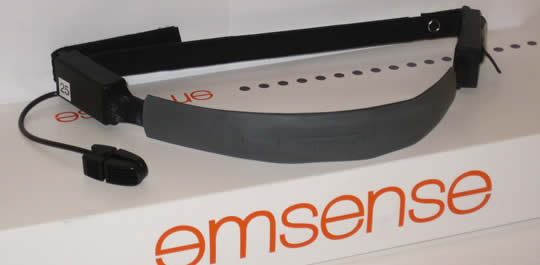Brain Scans In Your Home
 Brain scans (of a sort) are coming to a home near you. Neuromarketing firm EmSense has launched a new service that they say will let them monitor emotional reactions while consumers are at home. Noting that market research is conducted more and more via the Internet, EmSense says its wireless “EmBand” monitor can be set up in less than a minute and lets consumer reactions be monitored in the comfortable environment of their home.
Brain scans (of a sort) are coming to a home near you. Neuromarketing firm EmSense has launched a new service that they say will let them monitor emotional reactions while consumers are at home. Noting that market research is conducted more and more via the Internet, EmSense says its wireless “EmBand” monitor can be set up in less than a minute and lets consumer reactions be monitored in the comfortable environment of their home.
How it works
Consumers will go through a screening and opt-in process to qualify to be part of the “neuro-panel,” and then be shipped a headband and wireless receiver. These will connect to their PC.
Periodically, the panel members will receive an email invitation to participate in a study. They will go to a web page, don their headband, and be monitored as they view the content. The neuro-testing can be conducted for a variety of content types, including TV advertisements, virtual shopping, creative concepts, and movie trailers.
Goal: 25,000+ Panelists
EmSense CEO Keith Winter says the firm strives to measure “emotion and consumer engagement in all forms of marketing stimuli, spanning advertising, packaging, creative concepts and the shopper experience.” The in-home approach offers the advantages of a more natural setting, lower costs, and larger sample sizes. The firm claims to have more than 2,000 households enrolled in the home neuro panel, and plans to expand that to 25,000 by the end of 2011.
As with many approaches in neuromarketing, EmSense seems to be trading power for ease of use and cost. Critics will no doubt point out that a full EEG cap with many more sensors will provide far more data. Nevertheless, the sample sizes EmSense is shooting for are unprecedented and would be hard to achieve with more intrusive measurement techniques.
The firm claims to be able to differentiate between subjects using biometrics, eliminating the possibility of duplicate testers. (I.e., people won’t be able to use 10 phony names to sign up for EmBands in order to pocket more testing fees.) The EmBand includes accelerometers to detect if a subject has been distracted while viewing content.
